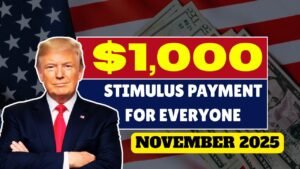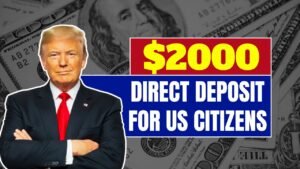The US inflation rate which has been increasing gradually over the past year has drastically influenced the lives of common people. Daily essentials especially groceries, gas, medical services, rent, and electricity and water bills have become more expensive than ever. People who were already in the paycheck-to-paycheck situation are now finding it harder to manage their household budgets. The $1,390 Direct Deposit Relief Payment payable by the Internal Revenue Service (IRS) has, nevertheless, inspired hope among millions of Americans who were under economic pressure.
The aim of this new relief program is to provide the necessary financial support for people to cover their basic needs, settle debts, and eventually, get their finances back on track by year’s end. The most significant aspect of this is that the money will be credited directly to the citizens’ bank accounts, hence, there won’t be any need for paper checks processing and waiting for long periods.
What is this $1,390 Direct Deposit Relief Payment Plan?
The US government has launched a relief program to deal with the impact of inflation and this is its major step to mitigate the consequence of rising prices. It is not the same as the stimulus checks provided during the pandemic. While pandemic relief payments were given to nearly all citizens, this program is intended just for those most affected by inflation.
The Internal Revenue Service intends to use its current databases of taxpayers as well as digital payment methods to make this amount available to eligible persons not only rapidly but also with high security. This measure is not single relief action but a part of the government’s continuous efforts to provide support to its citizens in economically challenging times.
The amount each individual receives will depend on their income, tax status, and credits or deductions claimed on their 2024 tax return.
Why is this relief plan necessary?
Presently, the scenario of daily life has become quite hard for the majority of families in America. The cost of living is going through the roof, medical care is hardly accessible, and food prices have almost doubled as compared to the period before COVID-19. The government subsidy of $1,390 will certainly save a number of families.
They will be able to pay off some of their debts, bills, or even have a little fun during the holidays.
In the opinion of economists, these kinds of programs not only benefit the families but also the economy as a whole. Increased spending power of people means that they will shop more and local markets will be the preferred choice, which will in turn create jobs and the economic cycle will be further strengthened.
Who is eligible for this relief payment?
The IRS has set clear eligibility standards so that this assistance reaches only those who truly need it.
| Category | Eligibility Standards | Estimated Amount |
|---|---|---|
| Single Tax Filer | Annual Income Less Than $75,000 | $1,390 |
| Joint Filer (Married Couple) | Joint Income Less Than $150,000 | $2,780 |
| Dependents | Partial Credit Depending on Status | Variable |
| Social Security Beneficiaries | Automatic Payment via Direct Deposit | $1,390 |
If you filed your 2024 tax return on time and your income falls within the standards described above, you don’t need to do anything extra. The IRS will automatically deposit the funds into your existing bank account.
Social Security, SSI (Supplemental Security Income), and SSDI (Social Security Disability Insurance) recipients will also have this amount automatically deposited into their accounts.
Payment Date – When Will You Receive the Money?
The IRS has stated that relief payments will start in November 2025, with the first people being those whose bank information is already in the IRS system.
In general, it takes about 3 to 5 business days for funds to show up in the accounts after payment is made. But those who have chosen to receive a paper check might have to wait longer due to the time it takes for the postal service to process the check.
The IRS will also make changes to the “Get My Payment” portal on its website, allowing people to check the status of their payments. This agency plans to distribute all the money to eligible Americans by mid-November 2025, thus enabling them to enjoy the relief from financial stress before Thanksgiving and the holiday season.
How to Check Payment Status?
The IRS’s official website provides two tools, “Where’s My Refund” and “Get My Payment,” through which individuals can find out the status of their payments. The only requirement is to provide the last four digits of one’s Social Security number, the tax filing status, and other necessary information.
In case you have changed your bank account or personal details recently, it is advisable to make the update right away in order to prevent getting the payment delayed. Processing times for different banks may vary, so it is possible that the funds sent by the IRS may take a few days to show up in your account.
Common Problems and Their Solutions
Delay in Payment: If your 2024 tax return hasn’t been processed yet, payments may be delayed. The solution is to complete your tax filing promptly.
- Incorrect Bank Details: If your bank account information is outdated or incorrect, payments may be delayed. Update your information on the IRS portal immediately.
- Beware of Scams: Fraudsters become active after every government scheme. Keep in mind that the IRS never asks for bank or personal information via phone, email, or SMS. If you receive such a message, ignore it and report it.
How is this relief plan different from previous stimulus checks?
The stimulus checks given during COVID-19 were universally distributed to all taxpayers. However, this relief amount of $1,390 is completely targeted. It aims to provide relief only to citizens directly affected by rising inflation.
Furthermore, this money is being disbursed directly through the tax and Social Security systems, greatly reducing the potential for fraud, and the entire process is faster and more secure than ever before.
This plan not only provides immediate relief, but also is a smart and responsible step toward long-term economic stability.
Its Impact on the Economy
When funds reach the accounts of millions of Americans simultaneously, the impact is felt across the nation’s economy.
- Increase in consumer spending: People’s purchasing power increases and they shop more at local businesses.
- Increase in employment opportunities: Companies hire more employees as demand increases.
- Debt reduction: Families are able to pay off their credit cards or loans, increasing financial stability.
- Empower communities: When money circulates locally, both small businesses and communities are strengthened.
What will happen to future IRS relief plans?
Economists believe that future relief plans will depend on the state of the economy, employment rates, and inflation levels. If this program proves successful, it’s possible the government will continue similar targeted relief plans into 2026 or beyond.
Conclusion: A Ray of Hope in Difficult Times
The $1,390 direct deposit refund check is more than just a government financial aid. It is a sign of the government care for people. At the same time, it is a struggle that teaches families about the importance of basic needs in a world where everything is becoming more expensive.
This money can be spent on different things like housing, health, or feeding a family, but it will still bring some relief and stability to all American families. With this plan, the government goes on to show its support for the people during hard times, and this step is a major move towards economic recovery for the country.
FAQs
Q1. What is the $1,390 direct deposit relief payment?
It’s a financial aid initiative from the IRS aimed at helping Americans cope with rising inflation by providing direct cash assistance to eligible citizens.
Q2. Who is eligible to receive this payment?
Single filers earning below $75,000, joint filers with income under $150,000, and Social Security beneficiaries automatically qualify.
Q3. When will the payments be issued?
The first phase of payments will begin in November 2025, with funds typically reaching bank accounts within 3–5 business days after processing.
Q4. Do I need to apply for this relief payment?
No application is needed. If you’ve filed your 2024 tax return and meet the income requirements, the IRS will send the payment automatically
Q5. How can I check my payment status?
You can visit the IRS website and use the “Get My Payment” tool by entering your Social Security Number and tax filing details.


